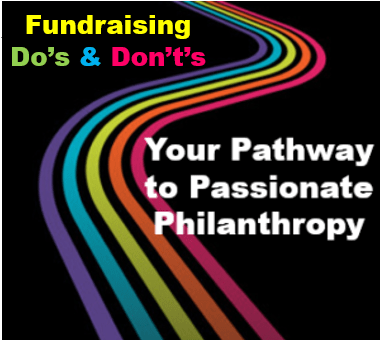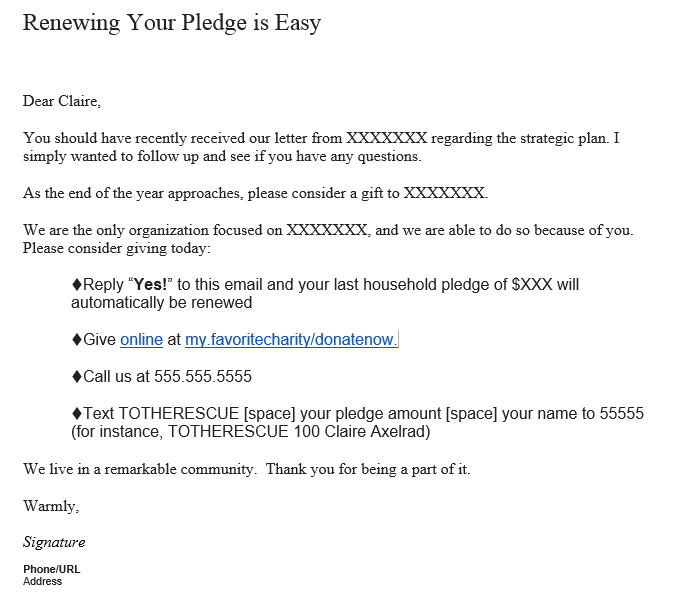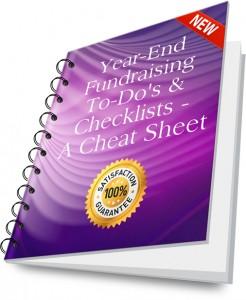 I’m continuing with my occasional “Do’s vs. Don’ts” feature which I began last spring. I promised whenever something arrives in my mailbox that seems a good ‘teaching opportunity,’ I would share it with you. I hope you find this timely example useful for your year-end fundraising ‘clean-up!’
I’m continuing with my occasional “Do’s vs. Don’ts” feature which I began last spring. I promised whenever something arrives in my mailbox that seems a good ‘teaching opportunity,’ I would share it with you. I hope you find this timely example useful for your year-end fundraising ‘clean-up!’
Clean-up? Yes. That’s exactly what I want you to do right now.
Get. Everything. In. Order.
Tie up loose ends so you assure nothing slips through the cracks before the calendar year closes.
Take a look at all your sources of support last year.
Who’s given this year already? Who hasn’t?
Important: Don’t let any of last year’s donors lapse!
If you’ve been reading Clairification for any time at all, you know first-time donor retention is pretty miserable. Unless you do something proactive to keep your supporters active, only 23% will renew (average 1st-time donor retention per Fundraising Effectiveness Project).
If you can get new donors to make a second gift, however, they’ll subsequently renew at a rate that’s almost triple that of first-time donors. In fact, at a rate of 61%. That’s a huge difference – so it’s well worth putting in the ‘clean up’ effort for anyone who’s (up to this point) only made a one-time gift.
One way to make this happen is through a series of year-end email appeals targeting almost-lapsed supporters.
Today’s teaching example is year-end email targeted to non-major donors who gave last year but not yet this year (known in the fundraising universe as LYBNTS – Last Year But Not This).
Let’s take a look…

Do you think it’s a “Do” or a “Don’t?”
I’ll tell you my own thoughts in a moment. But first…
Subject headline and preview pane:
- Would you open that email?
- If yes, why?
- If no, why?
Body of email:
- What looks good about it?
- What looks not so good?
- Were you the lapsed donor, would it inspire you to give?
- If so, why?
- If not, why not?
Think it through yourself because you’ll likely get more out of this if you do.
Seriously, I mean it. We learn best by doing.
This may help: Take three minutes and jot down your answers to the first three questions on a piece of paper or your screen. I want to know if what was in the subject headline (“Renewing Your Pledge is Easy”) or the email preview pane (Dear Claire, You should have recently receive our letter from XXXXXXX regarding our strategic plan. I simply wanted to follow up and see if you…) would have caused you to open the email or hit ‘delete.’
Okay. Ready to know my answers?
Make sure your email ‘envelope’ says “open me.”
Your email subject line and preview pane are the online equivalent of the direct mail envelope. You need to arouse curiosity and/or begin a conversation.
What’s wrong or right with this subject line?
Renewing Your Pledge is Easy.
It totally worked for me.
- They had me at the word “easy.”
Because, let’s face it, despite our best intentions to give — sometimes it’s just a bit too difficult.
- Remembering to hunt down that letter and remit envelope you put aside to deal with later…
- Actually hunting down that letter and remit envelope you put aside to deal with later…
- Finding your checkbook…
- Looking for a stamp…
- Taking the letter with your check to the mailbox…
- Or… remembering to look the organization up on your computer so you can click on the “donate” button…
- Or… remembering who to call at the organization so you can leave a credit card…
- Or… finding the phone number of the person you need to call to make a gift…
First world problems, to be sure. But, problems nonetheless.
This subject line begins a conversation that goes like this:
Charity: This will be easy.
Me: Tell me more about how it will be easy.
It sets up an expectation I’ll find something useful if I open the email.
- They reminded me I’d made a pledge to them in the past.
This channels one of Robert Cialdini’s six Principles of Persuasion and Influence: commitment and consistency.
Human beings are wired to fulfill their commitments. We want to be seen as consistent. So when you remind someone they gave to you in the past, it acts as a decision-making shortcut. They don’t have to decide today whether to give/not give, because they already went through the deliberation in the past and decided to give your cause a thumbs up!
What’s wrong or right with this preview pane?
Dear Claire, You should have recently receive our letter from XXXXXXX regarding our strategic plan. I simply wanted to follow up and see if you…
Here’s what I like:
- It’s personalized.
There’s no more donor-centered communication than one that uses a donor’s first name. Per Penelope Burk’s groundbreaking research in Donor-Centered Fundraising, perhaps the principle thing current donors want is this: “Show me that you know me.” Bottom line: more people open personalized emails than non-personalized ones.
- It reminds me I already received a letter, and this is just a follow up.
Somehow a ‘follow up’ seems casual and non-threatening. It also piques my interest, because I feel it’s something I’m supposed to know about. Something I apparently missed the first time around. But… now I have another chance!
- It leads me to wonder what they want to “see if I…”
Again, this feels personal. It’s not about them. It’s about me. Maybe they wonder if I have questions? Maybe they wonder if I can attend something? I don’t really know what they wonder – which makes me want to open the email.
Here’s what I don’t like:
- Minor quibble: “our strategic plan.”
I advise keeping all organization-centric words out of year-end fundraising messaging. Instead, they could have easily said “the 2019-2020 strategic plan.”
Remember: Any obstacle that stands between the donor and your organization at this time of year is an obstacle you don’t want to have!
Make sure your email body gets to the point!
What looks good about it?
Frankly, it doesn’t look good.
It also doesn’t look bad.
It’s a plain vanilla email that gets right to the point.
My hunch is this wasn’t the first email I received. I probably also received some with images and big donate buttons. But that was earlier in the year. And, I guess I didn’t notice them. I’m sure I should have. And, hopefully, other folks were inspired to give. But… remember, this is a ‘clean up’ email for folks like me where, maybe, the earlier email(s) arrived on a busy day where I hit ‘delete’ for most things.
This works really well as a next-to-last attempt to secure my gift.
- It reminds me they care about my feedback on the strategic plan – so it’s not just about the money.
- It makes it clear the organization only accomplishes its mission because of (aw, shucks) me.
- It gives me super-easy giving options – more than one! — via email, online, phone and text.
What looks not so good?
Okay, maybe it’s a bit too vanilla. An inspiring photo demonstrating impact wouldn’t hurt.
Were you the lapsed donor, would it inspire you to give?
Yes, it did!
If so, why?
There were numerous easy options. I liked that!
I hit ‘reply’ – and, actually, this is the first time I’ve ever seen this as an option. Cool.
If not, why not?
Unfortunately… I assumed they had my credit card on file and the pledge would, indeed, be “automatically renewed.” It seemed ever so slightly easier than clicking on the website link, so that’s what I chose. However… I received an email back that said: “Thank you so much! Your generosity is much appreciated, as always. I will send you a pledge confirmation form in the mail.”
Hmmn… so I guess my gift isn’t quite consummated yet? I haven’t received the promised form to-date, and it’s been a week since I hit “reply.” This is too long.
Lesson here: Make sure you have systems in place to immediately follow through with every donation tool you offer supporters. In our digital age, people need instant confirmation their gift was received, and it will be put to work as intended.
What do you think? Am I off base? Please share in the comments below.
Want More Help with Year-End Fundraising?

Your all-in-one guide for ticking off things you may be missing or not quite have finished
You may find my Year-End Fundraising Solution Kit – To-Do’s + Checklists useful. It’s not too late — a full third (33%) of December gifts occur on the 31st of the month!
You don’t want to miss making a few tweaks that could mean a big difference in your results. Anything you can’t get to this year you can plan ahead for next year.
Like all Clairification products, this comes with a 30-day, no-questions-asked, 100% refund guarantee. I want you to be successful!





